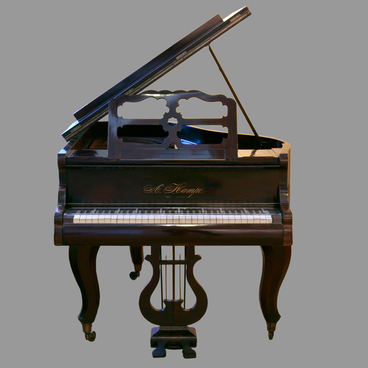The second-floor lobby of the Museum of Music houses the collection’s largest exhibit — the 1868 pipe organ. It was built by the craftsman Friedrich Ladegast in Weißenfels, Germany. This instrument has two keyboards called manuals, a pedalboard, sixteen stops, and a tracker action. An action refers to all moving parts and mechanisms that connect the keyboard to valves and other devices that allow air to flow into pipes or stop that flow.
Friedrich Ladegast was a famous 19th-century organ builder. He built around 250 pipe organs. Many of them are still used in Germany and other countries, including Poland, Latvia, Estonia, Austria, the Czech Republic, and Russia.
Ladegast’s most notable works include the four-manual pipe organs of the Merseburg Cathedral and the Nikolaikirche in Leipzig. His largest surviving instrument is the one at the Schwerin Cathedral. Such famous composers as Franz Liszt and Anton Bruckner have played his instruments.
The pipe organ from the museum’s collection is Ladegast’s only surviving instrument in Russia and the oldest pipe organ that is still used. It was commissioned by Vasily Khludov as a chamber instrument.
Vasily Khludov was a hereditary honored citizen, an entrepreneur, and one of the founders of Sochi. He played the piano and improvised on the organ. Khludov graduated from two departments at Moscow University and later attended a chemistry course at Heidelberg University where he got acquainted with Friedrich Ladegast. In 1886, Vasily Khludov donated the pipe organ to the Moscow Conservatory and provided financing for its transportation and repairs.
Many famous composers and organists studied and performed using this instrument, including Boris Sabaneyev, Alexander Goedicke, Garis Grodbergas, and Oleg Yanchenko. In 1959, the badly worn instrument was moved to the concert hall of Children’s Music School No. 1 in Moscow.
In 1987, the pipe organ was dismantled and stored at the Holy Trinity Church in Kozhevniki, and in 1992, the damaged instrument was received by the Glinka Museum of Musical Culture, nowadays known as the Russian National Museum of Music. Between 1996 and 1998, the organ was restored at the Vilnius Organ Workshop.
The restored instrument was commissioned in 1998. Ever since that time, the pipe organ has got new life in the museum where it is frequently used in the “Chamber Organ” concerts and other programs.
Friedrich Ladegast was a famous 19th-century organ builder. He built around 250 pipe organs. Many of them are still used in Germany and other countries, including Poland, Latvia, Estonia, Austria, the Czech Republic, and Russia.
Ladegast’s most notable works include the four-manual pipe organs of the Merseburg Cathedral and the Nikolaikirche in Leipzig. His largest surviving instrument is the one at the Schwerin Cathedral. Such famous composers as Franz Liszt and Anton Bruckner have played his instruments.
The pipe organ from the museum’s collection is Ladegast’s only surviving instrument in Russia and the oldest pipe organ that is still used. It was commissioned by Vasily Khludov as a chamber instrument.
Vasily Khludov was a hereditary honored citizen, an entrepreneur, and one of the founders of Sochi. He played the piano and improvised on the organ. Khludov graduated from two departments at Moscow University and later attended a chemistry course at Heidelberg University where he got acquainted with Friedrich Ladegast. In 1886, Vasily Khludov donated the pipe organ to the Moscow Conservatory and provided financing for its transportation and repairs.
Many famous composers and organists studied and performed using this instrument, including Boris Sabaneyev, Alexander Goedicke, Garis Grodbergas, and Oleg Yanchenko. In 1959, the badly worn instrument was moved to the concert hall of Children’s Music School No. 1 in Moscow.
In 1987, the pipe organ was dismantled and stored at the Holy Trinity Church in Kozhevniki, and in 1992, the damaged instrument was received by the Glinka Museum of Musical Culture, nowadays known as the Russian National Museum of Music. Between 1996 and 1998, the organ was restored at the Vilnius Organ Workshop.
The restored instrument was commissioned in 1998. Ever since that time, the pipe organ has got new life in the museum where it is frequently used in the “Chamber Organ” concerts and other programs.





